I Surveyed 483 SQL Users About Their Tools
I surveyed 483 database users about which databases and editors they use.
I learned what the most popular databases are, what the most popular editors are, and how often people choose the “default” editor for each database.

Background
In mid-2024, I created a simple 4-question survey.
It asked, what database vendors do you use, what editors do you use, your operating system, and your job role.
I sent this to people who have signed up to my email newsletter, and my YouTube subscribers.
Before I get into the results, there are a couple of caveats.
First, this was only sent to my subscribers, and not the wider data industry. You could say this skews the results a little towards the kind of content I create.
Second, it’s a much smaller sample size than other surveys such as Stack Overflow, but I think it’s still helpful.
Let’s look at the summary of each question and some interesting things I learned from the results.
Q1 - Most Popular Database Vendors
The first question was, “What database technologies do you work with?”
I had a multiple-choice list of answers as well as an Other textbox.
People were able to select more than one.
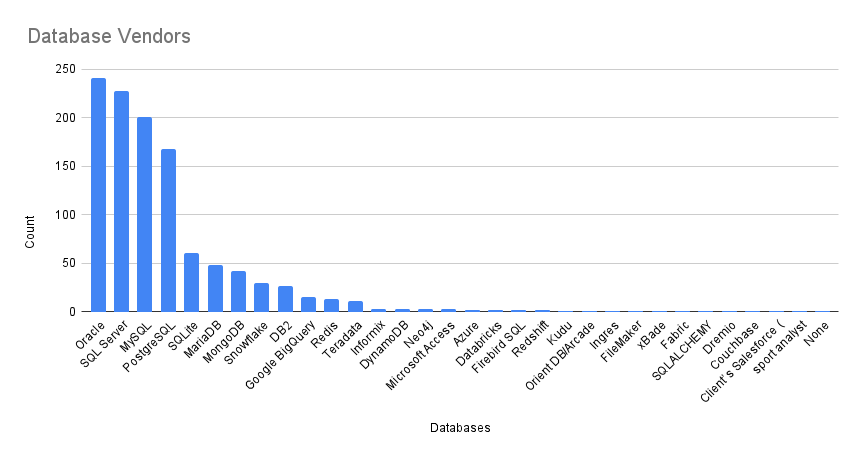
The most popular database is Oracle, with SQL Server a close second. MySQL was just behind in third, and PostgreSQL in fourth.
I’m not surprised by this, as for the first few years of my website and YouTube channel, I focused on Oracle content. I’ve recently created more content on these other three databases, so that may be a factor.
The next few on the list are SQLite and MariaDB, which is understandable as they are popular relational databases. We then have MongoDB, which is surprising as I don’t teach any NoSQL databases. But it’s popular and people use more than one type.
Here are the full results:
| Databases | Count |
|---|---|
| Oracle | 241 |
| SQL Server | 228 |
| MySQL | 201 |
| PostgreSQL | 168 |
| SQLite | 61 |
| MariaDB | 48 |
| MongoDB | 42 |
| Snowflake | 30 |
| DB2 | 27 |
| Google BigQuery | 15 |
| Redis | 13 |
| Teradata | 11 |
| Informix | 3 |
| DynamoDB | 3 |
| Neo4j | 3 |
| Microsoft Access | 3 |
| Azure | 2 |
| Databricks | 2 |
| Firebird SQL | 2 |
| Redshift | 2 |
| Kudu | 1 |
| Orient DB/Arcade DB | 1 |
| Ingres | 1 |
| FileMaker | 1 |
| xBade | 1 |
| Fabric | 1 |
| SQLALCHEMY | 1 |
| Dremio | 1 |
| Couchbase | 1 |
| Client’s Salesforce (gulp) | 1 |
| sport analyst | 1 |
| None | 1 |
Q2 - Most Popular Editors
The next question was, “Which SQL editor(s) do you use?”
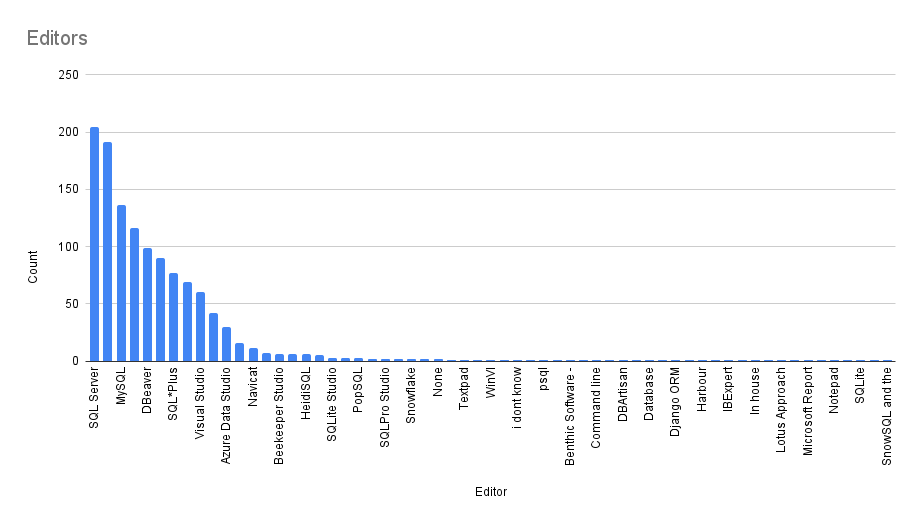
The most popular response was SSMS, the editor by Microsoft that comes with SQL Server.
Next was Oracle SQL Developer, mainly used for Oracle databases.
If you’re wondering why the top tool is for SQL Server but the top database was Oracle, we’ll find out later in this video.
We then have MySQL Workbench, and then in number 4 is Visual Studio Code which is surprising.
I know VS Code is popular for software development, but I didn’t know how popular it was for working with SQL.
Next, we have DBeaver, which is a cross-platform tool which I use for my Postgres work, and then pgAdmin, which is a popular tool for Postgres.
Many of these other tools I have heard of, and some I haven’t.
Here are the full results:
| Editor | Count |
|---|---|
| SQL Server Management Studio | 204 |
| Oracle SQL Developer | 191 |
| MySQL Workbench | 136 |
| Visual Studio Code | 116 |
| DBeaver | 99 |
| pgAdmin | 90 |
| SQL*Plus | 77 |
| Toad | 69 |
| Visual Studio | 60 |
| PL/SQL Developer (Allaround Automation) | 42 |
| Azure Data Studio | 30 |
| DataGrip | 16 |
| Navicat | 11 |
| TablePlus | 7 |
| Beekeeper Studio | 6 |
| Notepad++ | 6 |
| HeidiSQL | 6 |
| PHPMyAdmin | 5 |
| SQLite Studio | 3 |
| DBForge | 3 |
| PopSQL | 3 |
| Aqua Data Studio | 2 |
| SQLPro Studio | 2 |
| SQLYog | 2 |
| Snowflake Snowsight | 2 |
| DB Visualizer | 2 |
| None | 2 |
| Teradata Studio Express | 1 |
| Textpad | 1 |
| Toad Data Point | 1 |
| WinVI | 1 |
| dbKiss | 1 |
| i dont know | 1 |
| jupyter python modules for SQL | 1 |
| psql | 1 |
| Bbedit | 1 |
| Benthic Software - Golden 7 | 1 |
| Clipper | 1 |
| Command line interface for Informix | 1 |
| Compuware File-AID for DB2 | 1 |
| DBArtisan | 1 |
| DBGate | 1 |
| Database Workbench | 1 |
| Databricks web | 1 |
| Django ORM | 1 |
| Embarcadero | 1 |
| Harbour | 1 |
| Homemade Utility | 1 |
| IBExpert | 1 |
| IDEA Ultimate | 1 |
| In house developed platform | 1 |
| LextEdit | 1 |
| Lotus Approach | 1 |
| Microsoft Access VBA editor | 1 |
| Microsoft Report Builder 3.0 | 1 |
| MongoDBCompass | 1 |
| Notepad | 1 |
| Rapid SQL | 1 |
| SQLite | 1 |
| SequelAce | 1 |
| SnowSQL and the Snowflake console | 1 |
Q3 - Operating Systems
The third question was, “What operating system do you use?”
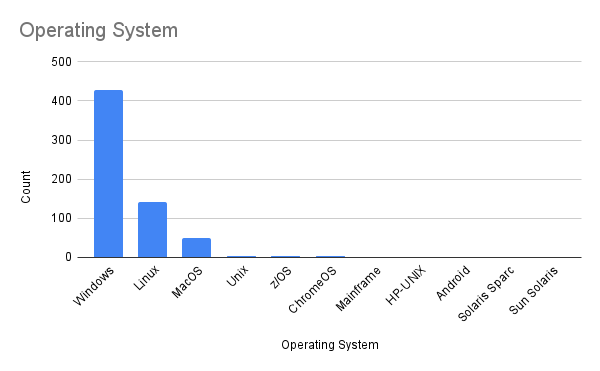
This was a multiple-choice question as well.
By far, the most popular response was Windows.
Second was Linux, which I thought was surprising.
In third place was MacOS, followed by a range of others.
Here are the full results:
| Operating System | Count |
|---|---|
| Windows | 429 |
| Linux | 142 |
| MacOS | 50 |
| Unix | 2 |
| z/OS | 2 |
| ChromeOS | 2 |
| Mainframe | 1 |
| HP-UNIX | 1 |
| Android | 1 |
| Solaris Sparc | 1 |
| Sun Solaris | 1 |
Q4 - Job Role
Question four was, “Which job title best describes your role?”
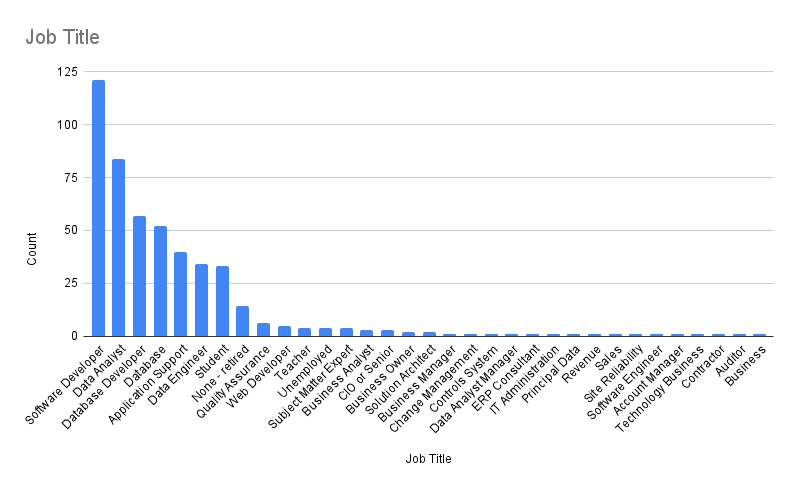
The most common response was Software Developer. Next was Data Analyst, then a couple of database roles such as Database Developer and Database Administrator.
It’s good to see that a wide range of roles use SQL. I’ve had a few of these roles and I remember using SQL at the time.
Here are the full results:
| Job Title | Count |
|---|---|
| Software Developer | 121 |
| Data Analyst | 84 |
| Database Developer | 57 |
| Database Administrator | 52 |
| Application Support | 40 |
| Data Engineer | 34 |
| Student | 33 |
| None - retired | 14 |
| Quality Assurance | 6 |
| Web Developer | 5 |
| Teacher | 4 |
| Unemployed | 4 |
| Subject Matter Expert | 4 |
| Business Analyst | 3 |
| CIO or Senior Management | 3 |
| Business Owner | 2 |
| Solution Architect | 2 |
| Business Manager | 1 |
| Change Management | 1 |
| Controls System Engineer | 1 |
| Data Analyst Manager | 1 |
| ERP Consultant | 1 |
| IT Administration | 1 |
| Principal Data Scientist and Architect | 1 |
| Revenue Management Analyst | 1 |
| Sales | 1 |
| Site Reliability Engineer | 1 |
| Software Engineer | 1 |
| Account Manager | 1 |
| Technology Business Consultant | 1 |
| Contractor | 1 |
| Auditor | 1 |
| Business Development | 1 |
Q5 - Number of Vendors
Now we’ll look into some further analysis of the responses.
How many different database vendors do people use?
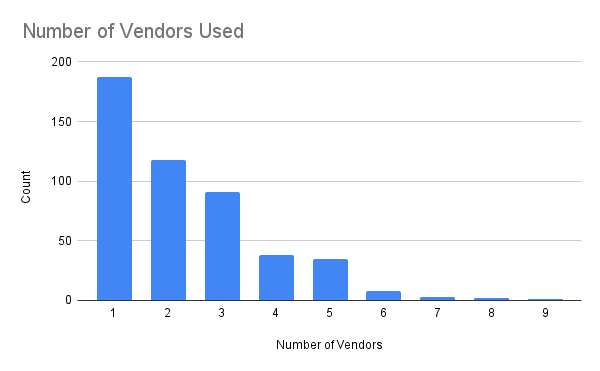
The most common response was 1, with about 38% of the responses. So, 38% of people use a single database vendor.
The frequency goes down as the number of vendors goes up, which is expected.
61% of people use more than one database vendor.
The most was 9, where one person reported using a combination of MySQL, PostgreSQL, Oracle, SQL Server, MongoDB, DB2, MariaDB, Google BigQuery, and Teradata.
Here are the full results:
| Number of Vendors | Count | Pct |
|---|---|---|
| 1 | 187 | 38.7% |
| 2 | 118 | 24.4% |
| 3 | 91 | 18.8% |
| 4 | 38 | 7.9% |
| 5 | 35 | 7.2% |
| 6 | 8 | 1.7% |
| 7 | 3 | 0.6% |
| 8 | 2 | 0.4% |
| 9 | 1 | 0.2% |

Q6 - Editors for Each Vendor
We saw what the most popular editors were earlier in the video.
Can we break this up by editor?
We can, but the results aren’t very precise. This is because the survey didn’t ask which tool was used with each vendor. It just captures the vendors and editors that are used.
So, if someone reported using Oracle and SQL Server, they may also say they use SQL Developer and SSMS. The results for this analysis would show SSMS in the Oracle list, which may or may not be correct.
So, I just wanted to mention that first.
Editors for Oracle
Here are the most popular editors for people who said they use Oracle.
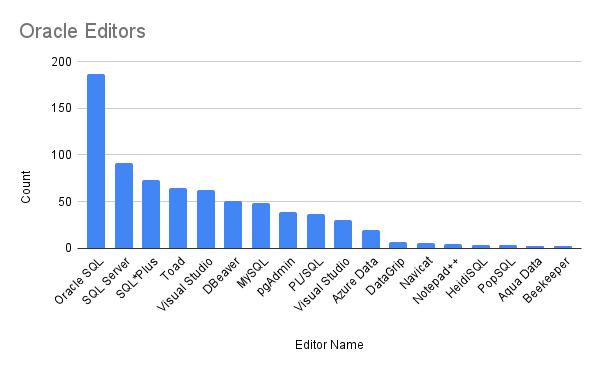
The top entry is SQL Developer.
We may be able to ignore SSMS here, because as I just mentioned, it’s hard to know if this is really for Oracle or for people who use Oracle and SQL Server.
The next response is SQL*Plus, a command-line editor for Oracle.
We then have other entries such as Toad, VS Code, and DBeaver.
Here are the full results:
| Editor Name | Count |
|---|---|
| Oracle SQL Developer | 187 |
| SQL Server Management Studio | 91 |
| SQL*Plus | 73 |
| Toad | 65 |
| Visual Studio Code | 62 |
| DBeaver | 51 |
| MySQL Workbench | 48 |
| pgAdmin | 39 |
| PL/SQL Developer (Allaround Automation) | 37 |
| Visual Studio | 30 |
| Azure Data Studio | 19 |
| DataGrip | 7 |
| Navicat | 5 |
| Notepad++ | 4 |
| HeidiSQL | 3 |
| PopSQL | 3 |
| Aqua Data Studio | 2 |
| Beekeeper Studio | 2 |
| Database Workbench | 1 |
| Rapid SQL | 1 |
| DBForge | 1 |
| LextEdit | 1 |
| SQLPro Studio | 1 |
| SQLYog | 1 |
| TablePlus | 1 |
| Textpad | 1 |
| DB Visualizer | 1 |
| Toad Data Point | 1 |
| Command line interface for Informix | 1 |
| Benthic Software - Golden 7 | 1 |
| WinVI | 1 |
| DBArtisan | 1 |
| In house developed platform | 1 |
| Embarcadero | 1 |
| PHPMyAdmin | 1 |
| Command line interface for Informix | 1 |
Editors for SQL Server
What about SQL Server?
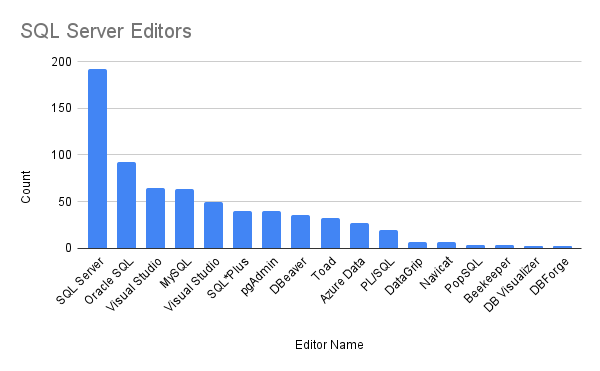
SSMS is the clear outlier here, and if we ignore SQL Developer and MySQL Workbench, we can see VS Code and Visual Studio high on the list here.
Here are the full results:
| Editor Name | Count |
|---|---|
| SQL Server Management Studio | 192 |
| Oracle SQL Developer | 93 |
| Visual Studio Code | 64 |
| MySQL Workbench | 63 |
| Visual Studio | 50 |
| SQL*Plus | 40 |
| pgAdmin | 40 |
| DBeaver | 35 |
| Toad | 32 |
| Azure Data Studio | 27 |
| PL/SQL Developer (Allaround Automation) | 19 |
| DataGrip | 7 |
| Navicat | 6 |
| PopSQL | 3 |
| Beekeeper Studio | 3 |
| DB Visualizer | 2 |
| DBForge | 2 |
| TablePlus | 1 |
| Toad Data Point | 1 |
| i dont know | 1 |
| MongoDBCompass | 1 |
| Command line interface for Informix | 1 |
| Compuware File-AID for DB2 | 1 |
| DBArtisan | 1 |
| DBGate | 1 |
| Database Workbench | 1 |
| Databricks web | 1 |
| Embarcadero | 1 |
| HeidiSQL | 1 |
| Homemade Utility | 1 |
| Microsoft Access VBA editor | 1 |
| Microsoft Report Builder 3.0 | 1 |
| Aqua Data Studio | 1 |
| Notepad | 1 |
| Notepad++ | 1 |
| SQLYog | 1 |
| SQLite Studio | 1 |
Editors for MySQL
Here are the results for MySQL.
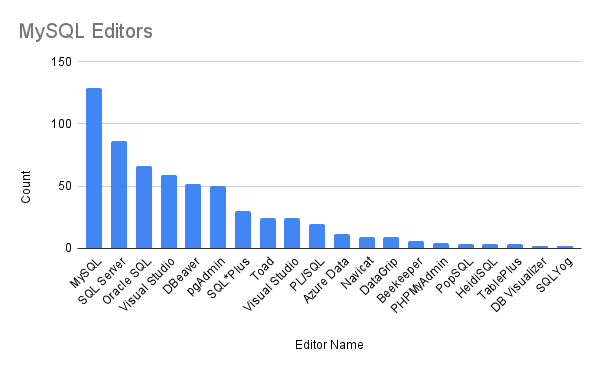
The most common editor is MySQL Workbench.
If we ignore SSMS and SQL Developer, we can then see VS Code and DBeaver.
There are a bunch of other tools that could be used with MySQL.
I noticed an entry here of SQL Yog. This was actually the first SQL editor I ever used, back in 2004 when I started learning MySQL.
Here are the full results:
| Editor Name | Count |
|---|---|
| MySQL Workbench | 129 |
| SQL Server Management Studio | 86 |
| Oracle SQL Developer | 66 |
| Visual Studio Code | 59 |
| DBeaver | 52 |
| pgAdmin | 50 |
| SQL*Plus | 30 |
| Toad | 24 |
| Visual Studio | 24 |
| PL/SQL Developer (Allaround Automation) | 19 |
| Azure Data Studio | 11 |
| Navicat | 9 |
| DataGrip | 9 |
| Beekeeper Studio | 6 |
| PHPMyAdmin | 4 |
| PopSQL | 3 |
| HeidiSQL | 3 |
| TablePlus | 3 |
| DB Visualizer | 2 |
| SQLYog | 2 |
| None | 1 |
| DBForge | 1 |
| In house developed platform | 1 |
| SQLPro Studio | 1 |
| SQLite Studio | 1 |
| SequelAce | 1 |
| Database Workbench | 1 |
| Homemade Utility | 1 |
| Toad Data Point | 1 |
| Embarcadero | 1 |
| Bbedit | 1 |
| dbKiss | 1 |
| i dont know | 1 |
| Compuware File-AID for DB2 | 1 |
| Notepad++ | 1 |
| Notepad | 1 |
Editors for Postgres
Now, for Postgres, the top entry is pgAdmin.
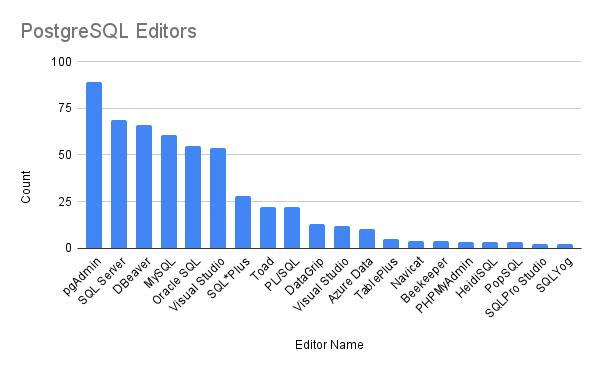
We can also see DBeaver high on the list, as well as VS Code.
In hindsight, I should have asked for the editors that are used for each vendor, as that could have been helpful to know and would result in a better analysis.
Let’s move on to the next question.
Here are the full results:
| Editor Name | Count |
|---|---|
| pgAdmin | 89 |
| SQL Server Management Studio | 69 |
| DBeaver | 66 |
| MySQL Workbench | 61 |
| Oracle SQL Developer | 55 |
| Visual Studio Code | 54 |
| SQL*Plus | 28 |
| Toad | 22 |
| PL/SQL Developer (Allaround Automation) | 22 |
| DataGrip | 13 |
| Visual Studio | 12 |
| Azure Data Studio | 10 |
| TablePlus | 5 |
| Navicat | 4 |
| Beekeeper Studio | 4 |
| PHPMyAdmin | 3 |
| HeidiSQL | 3 |
| PopSQL | 3 |
| SQLPro Studio | 2 |
| SQLYog | 2 |
| psql | 1 |
| Command line interface for Informix | 1 |
| Compuware File-AID for DB2 | 1 |
| DB Visualizer | 1 |
| DBForge | 1 |
| Django ORM | 1 |
| Embarcadero | 1 |
| IDEA Ultimate | 1 |
| Notepad++ | 1 |
| SQLite Studio | 1 |
| SequelAce | 1 |
| Toad Data Point | 1 |
| WinVI | 1 |
| i dont know | 1 |
| jupyter python modules for SQL | 1 |
| Aqua Data Studio | 1 |
Q7 - Default Editors
For the four main vendors that I cover, which are Oracle, SQL Server, MySQL, and Postgres, there’s one editor that comes with the database or is known as the default editor.
These are Oracle SQL Developer, SSMS, MySQL Workbench, and pgAdmin.
For this question, I wanted to know, how many respondents use these default editors?
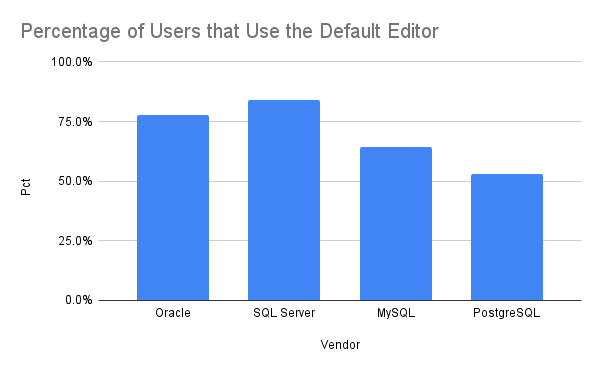
| Vendor | Count of People | Default Editor | Pct |
|---|---|---|---|
| Oracle | 241 | 187 | 77.6% |
| SQL Server | 228 | 192 | 84.2% |
| MySQL | 201 | 129 | 64.2% |
| PostgreSQL | 168 | 89 | 53.0% |
We can see these four databases here, the number of people who said they use this database, and the number of people who reported using these tools.
This means that 241 people said they use Oracle, and out of those, 187 said they use SQL Developer, which is 77%.
For SSMS and SQL Server, it was 84%. MySQL and MySQL Workbench is 64%, and Postgres and pgAdmin is 53%.
So, most SQL Server users will use SSMS to work with their database, at 84%.
For Postgres, the usage is much different, with about half using pgAdmin.
Q8 - Single Database Editors
Earlier in the video we learned that many people use a single database vendor.
What editors and database vendors are most popular for these people?
Here are the results.
| Database | Editor | Count |
|---|---|---|
| Azure | Azure Data Studio | 1 |
| DB2 | MySQL Workbench | 1 |
| DB2 | Oracle SQL Developer | 1 |
| DB2 | SQL Server Management Studio | 1 |
| Firebird SQL | IBExpert | 1 |
| MariaDB | HeidiSQL | 1 |
| MariaDB | TablePlus | 1 |
| MySQL | MySQL Workbench | 23 |
| MySQL | SQL Server Management Studio | 3 |
| MySQL | Visual Studio Code | 2 |
| MySQL | Navicat | 2 |
| MySQL | Bbedit | 1 |
| MySQL | None | 1 |
| MySQL | DBeaver | 1 |
| MySQL | DataGrip | 1 |
| None | None | 1 |
| Oracle | Oracle SQL Developer | 47 |
| Oracle | Toad | 14 |
| Oracle | SQL*Plus | 14 |
| Oracle | Visual Studio Code | 8 |
| Oracle | DBeaver | 5 |
| Oracle | PL/SQL Developer (Allaround Automation) | 4 |
| Oracle | Visual Studio | 3 |
| Oracle | SQL Server Management Studio | 2 |
| Oracle | Azure Data Studio | 1 |
| Oracle | LextEdit | 1 |
| Oracle | Aqua Data Studio | 1 |
| Oracle | MySQL Workbench | 1 |
| Oracle | Notepad++ | 1 |
| Oracle | Benthic Software - Golden 7 | 1 |
| PostgreSQL | pgAdmin | 13 |
| PostgreSQL | DBeaver | 10 |
| PostgreSQL | Visual Studio Code | 5 |
| PostgreSQL | PL/SQL Developer (Allaround Automation) | 1 |
| PostgreSQL | SQL*Plus | 1 |
| PostgreSQL | SQLPro Studio | 1 |
| PostgreSQL | jupyter python modules for SQL | 1 |
| PostgreSQL | psql | 1 |
| PostgreSQL | DataGrip | 1 |
| PostgreSQL | IDEA Ultimate | 1 |
| Redshift | DBeaver | 2 |
| SQL Server | SQL Server Management Studio | 49 |
| SQL Server | Visual Studio | 15 |
| SQL Server | Visual Studio Code | 9 |
| SQL Server | Azure Data Studio | 6 |
| SQL Server | Microsoft Report Builder 3.0 | 1 |
| SQL Server | Navicat | 1 |
| SQL Server | DBForge | 1 |
| SQL Server | DBGate | 1 |
| SQLite | Visual Studio Code | 1 |
| SQLite | DBeaver | 1 |
| SQLite | SQL Server Management Studio | 1 |
| SQLite | SQLite | 1 |
| SQLite | SQLite Studio | 1 |
| Snowflake | Snowflake Snowsight | 2 |
| Snowflake | Notepad++ | 1 |
| Snowflake | SnowSQL and the Snowflake console | 1 |
| Snowflake | Visual Studio Code | 1 |
| Teradata | Teradata Studio Express | 1 |
| sport analyst | Toad | 1 |
| xBade | Clipper | 1 |
| xBade | Harbour | 1 |
| xBade | Lotus Approach | 1 |
The tools for the popular databases such as Oracle and SQL Server are broken down here, which can help to see how popular they are compared to each other.
It shows generally what the preferred editors are if you’re only going to use one database.
Here are the full results:
Questions?
What did you think of this analysis and the results?
Is there anything else you’d like to know from this data?
Let me know in the comments below.
